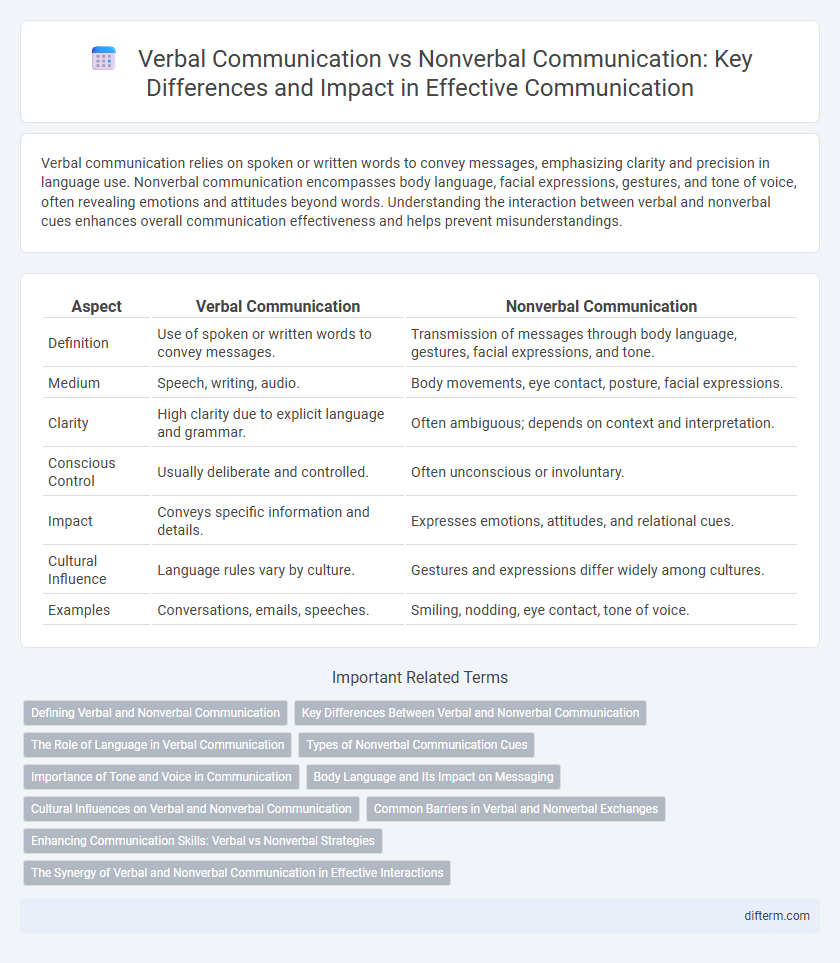Verbal communication relies on spoken or written words to convey messages, emphasizing clarity and precision in language use. Nonverbal communication encompasses body language, facial expressions, gestures, and tone of voice, often revealing emotions and attitudes beyond words. Understanding the interaction between verbal and nonverbal cues enhances overall communication effectiveness and helps prevent misunderstandings.
Table of Comparison
| Aspect | Verbal Communication | Nonverbal Communication |
|---|---|---|
| Definition | Use of spoken or written words to convey messages. | Transmission of messages through body language, gestures, facial expressions, and tone. |
| Medium | Speech, writing, audio. | Body movements, eye contact, posture, facial expressions. |
| Clarity | High clarity due to explicit language and grammar. | Often ambiguous; depends on context and interpretation. |
| Conscious Control | Usually deliberate and controlled. | Often unconscious or involuntary. |
| Impact | Conveys specific information and details. | Expresses emotions, attitudes, and relational cues. |
| Cultural Influence | Language rules vary by culture. | Gestures and expressions differ widely among cultures. |
| Examples | Conversations, emails, speeches. | Smiling, nodding, eye contact, tone of voice. |
Defining Verbal and Nonverbal Communication
Verbal communication involves the use of spoken or written words to convey messages, relying heavily on language and vocabulary for clarity and understanding. Nonverbal communication encompasses body language, facial expressions, gestures, posture, and eye contact, which provide contextual and emotional cues beyond verbal content. Both verbal and nonverbal communication work together to enhance message interpretation and social interaction effectiveness.
Key Differences Between Verbal and Nonverbal Communication
Verbal communication relies on spoken or written words to convey messages, emphasizing language structure, tone, and clarity, while nonverbal communication involves body language, facial expressions, gestures, and eye contact to express emotions and intentions. Key differences include verbal communication's use of explicit language and defined syntax versus nonverbal communication's reliance on implicit cues and contextual interpretation. Understanding these differences enhances interpersonal interactions by combining clarity from verbal messages with emotional depth from nonverbal signals.
The Role of Language in Verbal Communication
Language serves as the foundational system in verbal communication, enabling precise expression and interpretation of ideas through structured vocabulary and grammar. It facilitates the transmission of complex information, emotions, and intentions, making interactions clear and effective. Verbal communication's reliance on language allows for nuanced dialogue, cultural exchange, and the development of shared understanding across diverse contexts.
Types of Nonverbal Communication Cues
Nonverbal communication cues include facial expressions, body language, gestures, eye contact, posture, and proxemics, which convey emotions and attitudes without spoken words. Paralanguage, such as tone, pitch, and volume of voice, provides additional meaning to verbal messages. These nonverbal signals are critical for understanding context, regulating interactions, and enhancing or contradicting verbal communication.
Importance of Tone and Voice in Communication
Tone and voice in verbal communication significantly influence message interpretation and emotional connection between speakers. Variations in pitch, volume, and intonation convey attitudes and intentions beyond the spoken words, enhancing clarity and engagement. Effective use of vocal elements can prevent misunderstandings, making communication more impactful and authentic.
Body Language and Its Impact on Messaging
Body language plays a crucial role in shaping the effectiveness of verbal communication by providing visual cues that reinforce or contradict spoken words. Facial expressions, gestures, posture, and eye contact significantly influence message interpretation and emotional connection between communicators. Understanding and mastering nonverbal signals enhances clarity, builds trust, and prevents misunderstandings in interpersonal communication.
Cultural Influences on Verbal and Nonverbal Communication
Cultural influences significantly shape both verbal and nonverbal communication, affecting language use, tone, and context-specific expressions. High-context cultures rely heavily on nonverbal cues such as gestures, facial expressions, and silence, while low-context cultures emphasize explicit verbal messages and clarity. Understanding these cultural variations enhances effective cross-cultural communication and minimizes misunderstandings.
Common Barriers in Verbal and Nonverbal Exchanges
Common barriers in verbal and nonverbal communication include language differences, cultural misunderstandings, and emotional interference, which distort message clarity. Misinterpretation of tone, body language, or facial expressions often leads to confusion and conflict in interactions. Effective communication requires awareness of these barriers to accurately convey and receive intended messages in diverse contexts.
Enhancing Communication Skills: Verbal vs Nonverbal Strategies
Enhancing communication skills requires understanding the distinct impact of verbal and nonverbal strategies on message clarity and emotional expression. Verbal communication, including tone, vocabulary, and clarity, directly conveys information, while nonverbal cues like body language, facial expressions, and eye contact enrich meaning and build rapport. Mastery of both verbal and nonverbal communication techniques leads to more effective interactions and stronger interpersonal connections.
The Synergy of Verbal and Nonverbal Communication in Effective Interactions
Verbal communication conveys explicit messages through spoken or written language, while nonverbal communication reinforces these messages via body language, facial expressions, and tone of voice. The synergy of verbal and nonverbal communication enhances clarity, emotional impact, and understanding in interactions. Effective communicators align verbal content with nonverbal cues to build trust, emphasize points, and reduce misunderstandings.
verbal communication vs nonverbal communication Infographic

 difterm.com
difterm.com